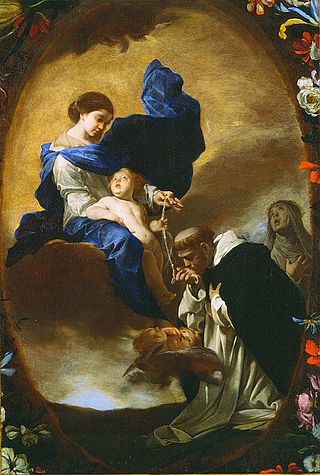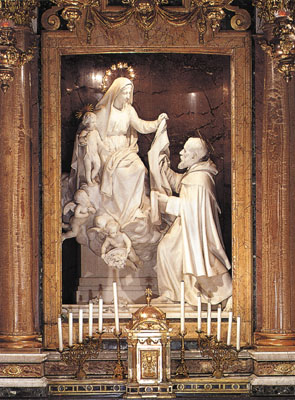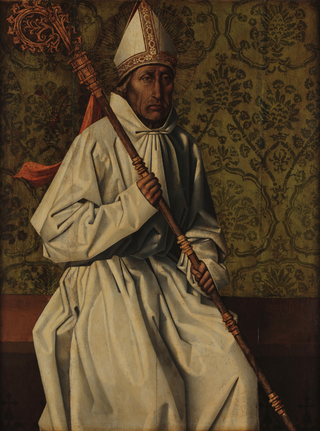See also
- Adelphopoiesis, Greek Christian brother making.
- Apostolate
- Confraternity of priests
- Sodality of Our Lady
In Christian theology, a sodality, also known as a syndiakonia, is a form of the "Universal Church" expressed in specialized, task-oriented form as opposed to the Christian church in its local, diocesan form (which is termed modality ). In English, the term sodality is most commonly used by groups in the Anglican Communion, Catholic Church, Eastern Orthodox Church, Lutheran Church and Reformed Church, where they are also referred to as confraternities. [1] Sodalities are expressed among Protestant Churches through the multitude of mission organizations, societies, and specialized ministries that have proliferated, particularly since the advent of the modern missions movement, usually attributed to Englishman William Carey in 1792.
In many Christian denominations, "modality" refers to the structure and organization of the local or universal church, composed of pastors or priests. By contrast, parachurch organizations are termed sodalities. These include missionary organizations and Christian charities or fraternities not linked to specific churches. Some theologians would include denominations, schools of theology, and other multi-congregational efforts in the sodality category. Sodalities can also include religious orders, monasteries, and convents.
The Latin word sodalis means "companion", a sodality being an organization of companions or friends. The sodalities of the Church are pious associations and are included among the confraternities and archconfraternities. Joseph Hilgers, writing in the Catholic Encyclopedia, states that it would not be possible to give a definition making a clear distinction between the sodalities and other confraternities. Confraternities and sodalities had their beginnings after the rise of the confraternities of prayer in the early Middle Ages (around 400–1000 AD), and developed rapidly from the end of the 12th century, with the rise of the great ecclesiastical orders, such as the Dominicans, the Carmelites, and the Servites. Other associations of this kind soon appeared under the jurisdiction of the local ordinary and had no particular connection with a religious order. [2]
During the Middle Ages, many of these pious associations placed themselves under the special protection of the Blessed Virgin and chose her as their patron. The main object and duty of these societies were, above all, the practice of piety and works of charity. By the end of the Middle Ages (around 1400 AD), the Church experienced a crisis and lost power and influence. Two hundred years later, in the 16th century, the Church rose to renewed prosperity and the many new religious congregations and associations gave birth to numerous new confraternities and sodalities which worked with great success and, in some cases, still exist. [2]
A useful way to understand sodalities, and their place in the Christian Church, is to divide the sodalities, pious associations and confraternities into three broad types: [2]
This group includes the confraternities which seek mainly to attain piety, devotion and the increase of love of God by special devotion to God, the Blessed Virgin, the angels, or the saints. In the first half of the twentieth century, such sodalities were the mainstay of Catholic parish life in many countries. [3]
According to Rene Metz, "[Catholic] [c]anon law provides for and favours pious associations of lay people...The best-known of the confraternities is that of the Most Blessed Sacrament". [4]

The Rosary, also known as the Dominican Rosary, refers to a set of prayers used primarily in the Catholic Church, and to the physical string of knots or beads used to count the component prayers. When referring to the prayer, the word is usually capitalized ; when referring to the prayer beads as an object, it is written with a lower-case initial letter.

Piety is a virtue which may include religious devotion or spirituality. A common element in most conceptions of piety is a duty of respect. In a religious context, piety may be expressed through pious activities or devotions, which may vary among countries and cultures.

A scapular is a Western Christian garment suspended from the shoulders. There are two types of scapulars, the monastic and devotional scapular; both forms may simply be referred to as "scapular". As an object of popular piety, a scapular serves to remind wearers of their commitment to live a Christian life.

The Scapular of Our Lady of Mount Carmel belongs to the habit of both the Carmelite Order and the Discalced Carmelite Order, both of which have Our Lady of Mount Carmel as their patroness. In its small form, it is widely popular within the Latin Church of the Catholic Church as a religious article and has probably served as the prototype of all the other devotional scapulars. The liturgical feast day of Our Lady of Mount Carmel, July 16, is popularly associated with the devotion of the Scapular.

A novena is an ancient tradition of devotional praying in Christianity, consisting of private or public prayers repeated for nine successive days or weeks. The nine days between the Feast of the Ascension and Pentecost, when the disciples gathered in the upper room and devoted themselves to prayer, is often considered to be the first novena.

The Sodality of Our Lady, also known as the Sodality of the Blessed Virgin Mary, is a Roman Catholic Marian society founded in 1563 by young Belgian Jesuit Jean Leunis at the Roman College of the Society of Jesus. The modern Ignatian lay group Christian Life Community traces its origins to the first Sodality.
Modality, in Protestant and Catholic Christian theology, is the structure and organization of the local or universal church. In Catholic theology, the modality is the universal Catholic church. In Protestant theology, the modality is variously described as either the universal church or the local church.

The Confraternities of the Cord are pious associations of Christians, the members of which wear a cord, girdle or cincture in honour of a Catholic saint or Angel whom they wish to honour and emulate.

Catholic devotions are particular customs, rituals, and practices of worship of God or honour of the saints which are in addition to the liturgy of the Catholic Church. The United States Conference of Catholic Bishops describes devotions as "expressions of love and fidelity that arise from the intersection of one's own faith, culture and the Gospel of Jesus Christ". Devotions are not considered part of liturgical worship, even if they are performed in a church or led by a priest, but rather they are paraliturgical. The Congregation for Divine Worship at the Vatican publishes a Directory on Popular Piety and the Liturgy.

The Roman Catholic Bona Mors Confraternity was founded 2 October 1648, in the Church of the Gesu, Rome, by Vincenzo Carafa, seventh General of the Society of Jesus. In 1729 it was raised to an archconfraternity by Benedict XIII. The object of the association is to prepare its members by a well-regulated life to die in peace with God.
An archconfraternity is a Catholic confraternity, empowered to aggregate or affiliate other confraternities of the same nature, and to impart to them its benefits and privileges.

A confraternity is generally a Christian voluntary association of laypeople created for the purpose of promoting special works of Christian charity or piety, and approved by the Church hierarchy. They are most common among Roman Catholics, Anglicans, Lutherans and the Western Orthodox. When a Catholic confraternity has received the authority to aggregate to itself groups erected in other localities, it is called an archconfraternity. Examples include the various confraternities of penitents and the confraternities of the cord, as well as the Confraternity of the Rosary.

Reparation is a Christian theological concept closely connected with those of atonement and satisfaction. In ascetical theology, reparation is the making of amends for insults given to God through sin, either one's own or another's. The response of man is to be reparation through adoration, prayer, and sacrifice. In Roman Catholic tradition, an act of reparation is a prayer or devotion with the intent to expiate the "sins of others", e.g. for the repair of the sin of blasphemy, the sufferings of Jesus Christ or as Acts of Reparation to the Virgin Mary.

The veneration of Mary in the Catholic Church encompasses various devotions which include prayer, pious acts, visual arts, poetry, and music devoted to her. Popes have encouraged it, while also taking steps to reform some manifestations of it. The Holy See has insisted on the importance of distinguishing "true from false devotion, and authentic doctrine from its deformations by excess or defect". There are significantly more titles, feasts, and venerative Marian practices among Roman Catholics than in other Western Christian traditions. The term hyperdulia indicates the special veneration due to Mary, greater than the ordinary dulia for other saints, but utterly unlike the latria due only to God.

Catholic Marian movements and societies have developed from the veneration of the Blessed Virgin Mary by members of the Catholic Church. These societies form part of the fabric of Mariology in the Catholic Church. Popular membership in Marian organizations grew significantly in the 20th century, as apparitions such as Our Lady of Fátima gave rise to societies with millions of members, and today many Marian societies exist around the world. This article reviews the major Marian movements and organizations.

The exact origins of both the rosary and scapular are subject to debate among scholars. Pious tradition maintains that both the rosary and the brown Scapular of Our Lady of Mount Carmel were given by the Virgin Mary to Dominic and Simon Stock respectively during the 13th century. Historical records document their growth during the 16th and 17th centuries in Europe. By the early 20th century, they had gained such a strong following among Catholics worldwide that Josef Hilgers, writing in the Catholic Encyclopedia of 1914, stated: "Like the Rosary, the Brown scapular has become the badge of the devout Catholic."
In order to associate the faithful, who were not Oblates of St. Benedict, in a certain measure with the Benedictine Order, a Confraternity of St. Benedict was founded in the second half of the nineteenth century, at first by the English Congregation.

Theotonius was a Canon Regular and royal advisor. He is noted in Portugal, for being the first prior of the Monastery of the Holy Cross in Coimbra, Portugal. He is celebrated as the reformer of religious life in Portugal, and is the first Portuguese saint.

The Queen of Angels Foundation is an association of lay faithful of the Catholic Church dedicated to fostering devotion to Mary, Mother of Jesus. The Foundation is a volunteer group of lay men and women who "...strive together in a common endeavor to foster a more perfect life for themselves and their community by promoting reverence for the Blessed Virgin Mary, in whose name, as Our Lady of the Angels, the City and Archdiocese of Los Angeles were founded..." and whom Catholics revere as Queen of Heaven and Empress of the Americas.

Our Lady of Consolation or Mary, Comforter of the Afflicted is a title of the Blessed Virgin Mary venerated in the Roman Catholic Church.